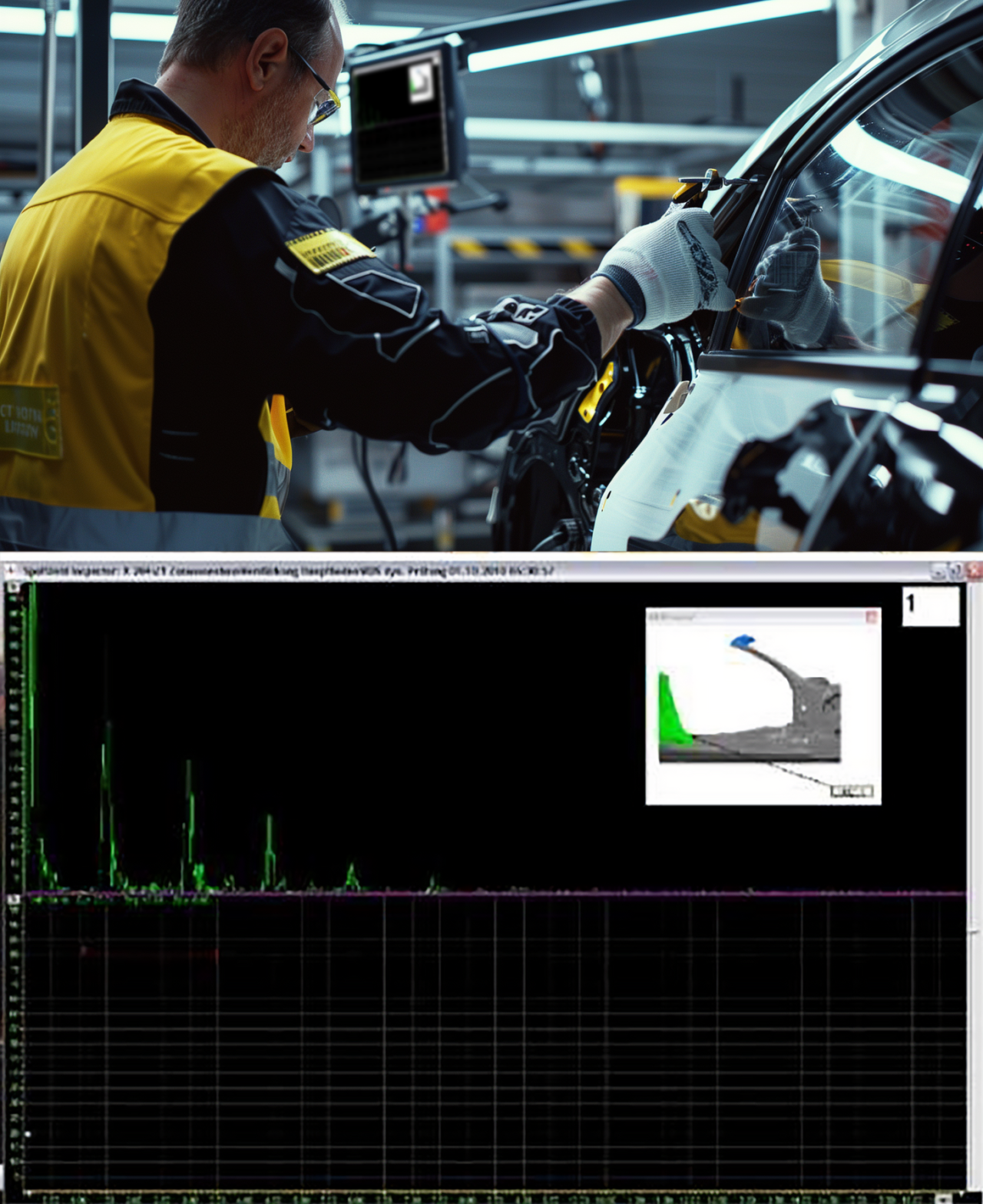Different industries also mean different requirements for materials and machines, but also for the software. One of the many strengths of our Quality Domain CAQ software lies in the wide range of possible applications in the most diverse sectors. Our satisfied customers include not only companies from the pharmaceutical, consumer goods and electronics industries, but also many well-known automotive manufacturers. Years of experience, innovation and the experience of a large number of satisfied customers have made us what we are today.
Quality Domain - a successful partner to the automotive industry
Initial situation and special features of the automotive industry

In times of global competition, increased safety requirements, the unpredictable development of energy costs, supply bottlenecks and increasing uncertainty due to the growing number of corporate mergers, the remaining market participants are being forced to become more efficient and productive.
Fixed costs must be reduced, which unfortunately often results in a reduction in personnel. This is exacerbated by increasing customer requirements and the individualization of products.
In these difficult times, the use of CAQ software is essential for companies in the automotive industry. It improves the chances of surviving on the global market and helps companies to cope with the ever-increasing competitive pressure.

Strengths of the quality domain

Our Quality Domain software is probably one of the most versatile CAQ software currently available on the German market. It supports you in all areas of your quality assurance and paves the way for a continuous improvement process. By using the software, you can analyze quality-relevant data right at the start of the production process in order to detect key errors, tolerance violations or trends at an early stage.
Thanks to the central storage of all relevant quality data, the traceability of each individual piece of information is possible without great effort – so that, in combination with our complaint management software, the causes can be easily and specifically tracked down and rectified as quickly as possible. With the help of our traceability software, you can find part IDs and batch data more easily and carry out process improvements more efficiently – resulting in increased customer satisfaction.

Dynamic test severity control
An important, because cost-saving, aspect of the software is the dynamic control of inspection accuracy. It is based on the process data that is collected directly during the production process and documented on a daily basis, such as various quality-relevant parameters that welding robots transmit to the software during the welding process. This makes it easy to identify conspicuous welding points so that a targeted inspection can then be carried out that is limited to these conspicuous points. This process drastically reduces the number of inspections and the associated costs.
Handling the software
Another strength of the software is its user-friendliness, which we receive time and again from our customers. This is due to the clear design and self-explanatory functionality. This also includes the quick and easy familiarization of employees with the software. This is done individually according to user groups, so that each employee receives training specifically tailored to their area of responsibility.
In addition to the special training models, the user profiles can also be customized to ensure that the software remains clear for each individual. The inspector is therefore quickly able to enter measurement data, which is then analyzed by the process monitor over a longer period of time in order to detect process changes, such as repeat errors, using long-term analyses.
Continuous adaptation of the software
Joining technologies in the automotive industry have developed rapidly in recent years, with the result that numerous different technologies are currently in use. The integration of new joining technologies into the software is an ongoing process, ensuring that you can always integrate the latest technologies that the market has to offer.
Connection of process and product data

The software enables you to bridge the gap between product data and quality-relevant process data. Not only can all process data collected during production using the various joining techniques be accessed centrally in the software, but also all product information from the various systems, such as ERP or CATIA. With the Report Designer, this data can then be displayed in correlation with each other in meaningful evaluations. The flexible creation of test certificates, weekly and monthly evaluations, measurement reports or capability certificates is also extremely simplified.
The Report Designer offers a variety of standard display formats. If these are not sufficient, you can even create new individual reports with little effort. By integrating graphics, photos and CAD drawings (including MIBA), reports can be adapted to individual requirements. However, the software can not only centrally manage the product and process data mentioned, but of course also all other process data, such as from coordinate measuring machines, gap and transition measuring devices or torque wrenches.

Application example: Testing spot welds with ultrasound
The picture at the top right shows an employee checking spot welds with an ultrasound device. These results are then displayed on a monitor, as shown in the picture below. QDA provides a visual representation with the exact position of the individual measuring points as support for the ultrasonic inspection, which is also displayed as a 3D graphic on the monitor.
Why companies in the automotive industry choose us
Thanks to our global service and short implementation times for software problems or inquiries, we always manage to convince our customers of us and our products and build up a long-term working relationship based on trust. Many customers appreciate the close and good cooperation with our colleagues, who are always able to think their way into the most diverse problems of the respective project. Following a large number of discussions and analyses, optimal solutions are then sought together and individual decisions are made. Thanks to the good contact that continues beyond the project, the software can be continuously and optimally adapted to the constantly changing production processes.
Get in touch!
Would you like to know more about our solutions? Then please write us using the contact form. My colleagues and I look forward to exchanging ideas with you.

Dominik Weggler
Head of Sales Germanedge
Customer use case: use of predictive quality analytics in body-in-white contruction
The topic of predictive quality analytics is playing an increasingly important role in the planning of many companies. When it comes to the concrete implementation of a solution in the customer environment, not only the technology but also a deep understanding of the processes by all those involved is required.
We present a typical use case as an example white predictive quality analysis in body-in-white production in the automobil sector:

Initial situation
In the past, individual inspection orders were generated on the basis of predefined static inspection plans. In SPC data acquisition, either parts are acknowledged as ‘OK’ or ‘NOK’ in relation to the respective inspection order, using SPC software for manufacturing. In order to obtain an overview of the reported defects, all defect information including images is recorded and displayed. In the specific customer case, more than 10 employees are permanently involved in ultrasonic testing.


Solution – AI-based process optimization
In a joint project from 2019, the basis for the implementation of an AI-based process optimization was set up. One of the aims was to support anomaly detection with a defined algorithm and reduce the scope of inspections. The process data is compared with other welding information already in the system for this purpose. This makes it possible to decide in real time whether the welded spot that has been classified as “n.I.O.” is relevant for a manual re-inspection and needs to be re-inspected by an inspector. In this case, the body is directed to a designated inspection station and the inspector can use an overview to check all the anomaly points collected.
The number and effort of manual ultrasonic inspections has been reduced by more than half thanks to the “Predictive Quality Analytics” approach.


Results and benefits
- By integrating “Predictive Quality Analytics” into the existing inspection strategy, the quality of the ultrasonic inspection is significantly increased, as only conspicuous spot welds (anomaly points) are inspected in addition to the existing equipment inspection.
- The integration of “Predictive Quality Analytics” increases the inspection rate to 100% of all welded spots.
- The image database enables a visual representation of the spot welds to be inspected and feedback on the anomaly points.
- As a result, the customer has achieved a significant reduction in manual ultrasonic inspections.

Get in touch!
Would you like to know more about our solutions? Then please write us using the contact form. My colleagues and I look forward to exchanging ideas with you.

Dominik Weggler
Head of Sales Germanedge




